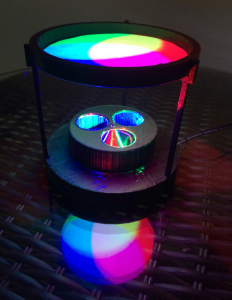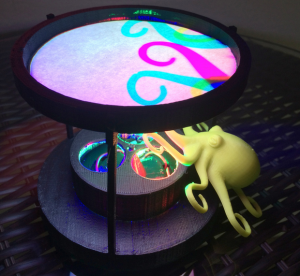 Not every project is going to work exactly as expected–in fact, most projects, devices or experiments will most likely end in failure. But dealing with a failure is an incredibly important skill that is often just as important as our successes. Personally I rarely consider anything a failure unless I don’t learn a lesson from it because in reality, a failure is just part of the process of creation. For just about any task we perform, learning how to do something is often just as important as learning why not to do that something a specific way. Sometimes we learn what not to do by seeing how other people do it and sometimes we learn what not to do by having things blow up in our faces, but both produce similar results as we find better ways to do what we were trying to do.
Not every project is going to work exactly as expected–in fact, most projects, devices or experiments will most likely end in failure. But dealing with a failure is an incredibly important skill that is often just as important as our successes. Personally I rarely consider anything a failure unless I don’t learn a lesson from it because in reality, a failure is just part of the process of creation. For just about any task we perform, learning how to do something is often just as important as learning why not to do that something a specific way. Sometimes we learn what not to do by seeing how other people do it and sometimes we learn what not to do by having things blow up in our faces, but both produce similar results as we find better ways to do what we were trying to do.
It is also important to remember that not every project that turns out differently than intended should be considered a failure. Sometimes we do things that didn’t turn out the way that we wanted, but we still end up with something that is useful or pretty cool. The microwave oven, Teflon coating, Velcro and even Play-Doh and Silly Putty are all the byproducts of experiments that were performed with different goals in mind. Now I’m not suggesting that Thingiverse user Marcio Teixeira’s Rainbow Apparatus is the next microwave oven, because obviously not. But the fact that he intended to create a different device than he ended up with doesn’t make the final result any less of a success.
“The Rainbow Apparatus is the latest and most ambitious in a series of designs based on a ray casting principle. The idea is that you start with the illumination pattern you desire and then construct a 3D printed object with holes that project that precise pattern. My use of this technique was inspired by the stereographic projection work of Henry Segerman and Saul Schleimer. In its current form, The Rainbow Apparatus is much simpler than it was originally conceived. At the start, it was an attempt to paint a recognizable color picture using light. When this didn’t pan out, it was rebranded as an interactive light piece,” Teixeira explained.
The device, as originally intended, would have cast light using the three primary colors of red, green and blue. By projecting the light in specific arrangements and patterns through a 3D printed filter, Teixeira believed that he could paint full color pictures with light. Similar to the effects of the popular t-shirt printing process offset lithography, the device would create complex, multi-colored images–only they would be made of projected light, not pigmented paints or dyes. Teixeira intended his “filters” to be 3D printed discs that could be placed inside of the Rainbow Apparatus and project the colored designs on the screen.
While the concept is sound, unfortunately Teixeira’s 3D printer was not up to the task and the final printed discs simply projected a blurry mass of light. Teixeira had to admit to himself that a standard FDM 3D printer would just not be able to produce the print accuracy that such a device would require. But thankfully, Teixeira saw the value in the device that he did create, and even without the light-painting discs the Rainbow Apparatus still had value. Not just as a cool lamp, but the apparatus refracts and alters the shadows of objects placed in front of the light projectors. This makes it ideally suited for demonstrating the concept of additive colors in a physics classroom setting.
Take a look at some video of the Rainbow Apparatus in action:
Teixeira designed all of the 3D printed parts for the apparatus using OpenSCAD, and he has happily shared the source code on Thingiverse. He combined the printed components with three high-powered red, green and blue LED lights and a basic power supply. He suggests either an adjustable benchtop power supply or a power adapter connected to an adjustable DC-to-DC buck converter, both options being fairly easy for most makers to source.
Have you had any projects turn out differently than intended? Let us know about them over on our 3D Printed Rainbow Apparatus forum thread at 3DPB.com.
Subscribe to Our Email Newsletter
Stay up-to-date on all the latest news from the 3D printing industry and receive information and offers from third party vendors.
You May Also Like
Profiling a Construction 3D Printing Pioneer: US Army Corps of Engineers’ Megan Kreiger
The world of construction 3D printing is still so new that the true experts can probably be counted on two hands. Among them is Megan Kreiger, Portfolio Manager of Additive...
US Army Corps of Engineers Taps Lincoln Electric & Eaton for Largest 3D Printed US Civil Works Part
The Soo Locks sit on the US-Canadian border, enabling maritime travel between Lake Superior and Lake Huron, from which ships can reach the rest of the Great Lakes. Crafts carrying...
Construction 3D Printing CEO Reflects on Being Female in Construction
Natalie Wadley, CEO of ChangeMaker3D, could hear the words of her daughter sitting next to her resounding in her head. “Mum, MUM, you’ve won!” Wadley had just won the prestigious...
1Print to Commercialize 3D Printed Coastal Resilience Solutions
1Print, a company that specializes in deploying additive construction (AC) for infrastructure projects, has entered an agreement with the University of Miami (UM) to accelerate commercialization of the SEAHIVE shoreline...





























